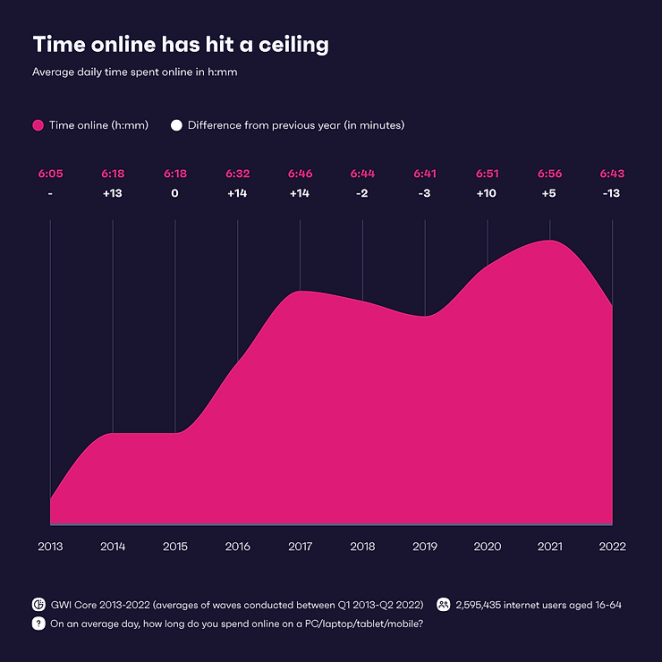GWI, an audience insights technology company, has just published a forecast report with 5 of the most need-to-know trends for anyone looking to understand the consumer mindset in the year ahead. Taker | Maker has highlighted the report's key insights and numbers for you. Let's start with the first trend.
Everything, everywhere, all at once
Let’s be clear, the internet isn’t going anywhere. 5 billion people use it and that number is going to keep growing. The way we use and even feel about it, however, has changed. It’s become less functional, with fewer using it to browse and search for information.
Countries and sources can vary, but most adults are awake for around 15 hours a day. In that time, they average 6 hours and 43 minutes online through mobile, PC, laptop, or tablets.
In a nutshell, that means almost half of the time spent awake is spent online.
While more people spent more time online during Covid, the daily average is now almost on par with pre-pandemic figures. It’s a potential sign that we’ve reached a kind of internet saturation point, people have less free time now, and fewer are using the internet day-to-day than they did in lockdown.

Improving the online experience
For most people aged 25 and over, the Google search bar is their starting point when they go online. And finding information is the number one reason consumers in our data say they use the internet, but it’s also one of the fastest-falling reasons why they use it, too (-14% since Q3 2018).
Finding information doesn’t quite mean the same thing it used to. Social media algorithms can surface it before we even know what we’re looking for. It's why Gen Z, outside of China, use Instagram almost as often as they do Google
Foundational internet behaviors are slipping. Other things like sharing opinions, keeping up with news, and generally browsing the internet are down too.
As the things we often do online lose the kind of appeal they once had, it sends a clear message that brands need to get creative. Consumers want to know their online time isn’t being wasted.

Making virtual a reality
So now heads are turning to Web3; heralding the metaverse as the ‘next stage’ of the internet.
Meta, of course, has made no secret of its ambitions here – along with Epic Games, the Roblox Corporation, and Tencent. These aren’t new names; they’re pioneers of established social media platforms and popular video games. And that’s exactly why they’re eyeing up the opportunities associated with Web3.
We’ve already made note of some important lessons ahead of the first true metaverses, but even though our data hints at significant metaverse interest among consumers, Web3 will still need to overcome familiar problems – particularly around trust.
Seeing is believing
The term “information overload” predates the internet, but in a world where we can access anything, anywhere, it’s become a lot more poignant.
Globally, the number of consumers who say social media causes them anxiety has grown 11% since Q2 2020 – again, with Gen Z and millennials the most likely to say this.
Trust is becoming an issue too, and there are subtle hints that this is the case. Fewer people cite looking for the opinions of experts or other people online when buying new products.
It’s potentially why we’re not just seeing online time plateau, but time on social too, as more consumers are taking steps to reduce their time online – a 14% increase since Q2 2020.
Between 2017 and 2021, we observed a stark decline in the number who trusted major news publishers. In the time since, we’ve watched as consumers gradually lose interest in knowing what happens around the world, while distrust in the media among Americans keeps on rising.
More people now say they see news on social media than they do on a news website, app, or anywhere else on the internet. With misinformation the number one frustration consumers have with social media, it’s little wonder why people are beginning to lose their trust in the things they see online – even if platforms are taking steps to address this.

Creating a captivating internet experience
As we cover in this report, the ramifications of this trend are incredibly broad. Addressing it will be a challenge for different sectors and businesses, but one possible solution lies in ‘blink and you’ll miss it’ experiences – things internet users can only do once a day, but also want to do.
Snapchat made this a key feature of its service long ago, but now it’s part and parcel of things like Wordle and BeReal.
As time online falls, incentivizing daily use opens the door for endemic internet sites (news services, search engines, and social media) to thrive in an attention economy that’s more crowded than ever – without falling prey to issues with health and trust.






